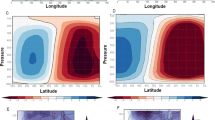Abstract
Many natural hazards are associated with deep convective clouds. Among them, mesoscale convective systems characterized by a large size and a long duration are the most dangerous. The estimates of their area, cloud top height, moisture content, duration, and intensity of related thunderstorm activity for Western Siberia were obtained using the data of radio and optical (passive and active) satellite sounding (for the summer months in 2010–2019) and World Wide Lightning Location Network (WWLLN, 2016–2020).



Similar content being viewed by others
REFERENCES
S. M. Abdullaev, A. A. Zhelnin, and O. Yu. Lenskaya, "The Structure of Mesoscale Convective Systems in Central Russia," Meteorol. Gidrol., No. 1 (2012) [Russ. Meteorol. Hydrol., No. 1, 37 (2012)].
A. V. Bykov and A. N. Shikhov, "Mesoscale Convective Systems Forecast Using Global and Mesoscale Atmospheric Models," Sovremennye Problemy Distantsionnogo Zondirovaniya Zemli iz Kosmosa, No. 2, 15 (2018) [in Russian].
N. F. Vel’tishchev and V. M. Stepanenko, Mesometeorological Processes (MGU, Moscow, 2006) [in Russian].
V. P. Gorbatenko, I. V. Kuzhevskaya, K. N. Pustovalov, V. V. Chursin, and D. A. Konstantinova, "Assessment of Atmospheric Convective Potential Variability in Western Siberia in Changing Climate," Meteorol. Gidrol., No. 5 (2020) [Russ. Meteorol. Hydrol., No. 5, 45 (2020)].
A. A. Evtushenko and E. A. Mareev, "Generating Electric-discharge Layers in Mesoscale Convective Systems," Izv. Akad. Nauk, Fiz. Atmos. Okeana, No. 2, 45 (2009) [Izv., Atmos. Oceanic Phys., No. 2, 45 (2009)].
V. A. Zhukova, T. S. Koshikova, and I. V. Kuzhevskaya, "Estimating Parameters of Mesoscale Convective Complexes Based on Satellite and Aerological Data (Western Siberia)," Geosfernye Issledovaniya, No. 2 (2019) [in Russian].
N. K. Kononova, "Northern Hemisphere Atmospheric Circulation Features in the Late 20th–Early 21st Centuries and Their Displays in Climate," Slozhnye Sistemy, No. 2 (2014) [in Russian].
I. V. Kuzhevskaya, K. N. Pustovalov, and A. A. Sharapova, "Characteristics of Convective Clusters Reconstructed from Data Obtained with ATOVS Sensing Tools," Fundamental’naya i Prikladnaya Klimatologiya, No. 2 (2018) [in Russian].
P. M. Nagorskiy, V. N. Morozov, S. V. Smirnov, and K. N. Pustovalov, "Electrode Layer in the Electric Field of Deep Convective Cloudiness," Izv. Vuzov, Radiofizika, No. 11, 56 (2013) [in Russian].
N. V. Podnebesnykh and I. I. Ippolitov, "Large-scale Atmospheric Circulation over Siberia at the End of the 20th and the Beginning of the 21st Centuries: A Comparison of Data Obtained on the Basis of Surface Synoptic Charts and the Reanalysis," Fundamental’naya i Prikladnaya Klimatologiya, No. 2 (2019) [in Russian].
K. N. Pustovalov and P. M. Nagorskiy, "The Main Types of Electric Field Variations during the Passage of Cumulonimbus Clouds of Different Genesis," Optika Atmos. Okeana, No. 8, 29 (2016) [in Russian].
Synoptic Charts with Frontal Analysis (2022), https://meteoinfo.ru/mapsynop [in Russian].
A. A. Sprygin, "Parameters of Long-lived Severe Convective Structures in the European Part of Russia and Neighboring Regions and the Possibility to Unify Their Forecast," Gidrometeorologicheskie Issledovaniya i Prognozy, No. 1 (2020) [in Russian].
E. L. Tunaev and V. P. Gorbatenko, "Energy Characteristics of the Atmosphere during Cyclogenesis over the Vasyugan Swamp," Gidrometeorologicheskie Issledovaniya i Prognozy, No. 4 (2018) [in Russian].
A. V. Chernokulsky, A. V. Eliseev, F. A. Kozlov, N. N. Korshunova, M. V. Kurgansky, I. I. Mokhov, V. A. Semenov, N. V. Shvets’, A. N. Shikhov, and Yu. I. Yarinich, "Atmospheric Severe Convective Events in Russia: Changes Observed from Different Data," Meteorol. Gidrol., No. 5 (2022) [Russ. Meteorol. Hydrol., No. 5, 47 (2022)].
J. A. Augustine and K. W. Howard, "Mesoscale Convective Complexes over the United States during 1986 and 1987," Mon. Wea. Rev., 119 (1991).
CALIPSO: The Cloud-Aerosol Lidar and Infrared Pathfinder Satellite Observation (2022), https://www-calipso.larc.nasa.gov.
A. V. Chernokulsky, O. N. Bulygina, and I. I. Mokhov, "Recent Variations of Cloudiness over Russia from Surface Daytime Observations," Environ. Res. Lett., No. 3, 6 (2011).
CloudSat Data Processing Center (2022), http://www.cloudsat.cira.colostate.edu.
EOSDIS Worldview (2022), https://worldview.earthdata.nasa.gov/.
J. M. Fritsch, R. J. Kane, and C. H. Chelius, "The Contribution of Mesoscale Convective Weather Systems to the Warm Season Precipitation in the United States," J. Appl. Meteorol. Climatol., 25 (1986).
R. A. Houze Jr., Cloud Dynamics, 2nd ed. (Elsevier, 2014).
R. A. Houze Jr., "Mesoscale Convective Systems," Rev. Geophys., 42 (2004).
M. L. Hutchins, R. H. Holzworth, J. B. Brundell, and C. J. Rodger, "Relative Detection Efficiency of the World Wide Lightning Location Network," Radio Science, No. 6, 47 (2012).
I. V. Kuzhevskaia, M. A. Volkova, O. E. Nechepurenko, and V. V. Chursin, "A Study of Hailstorms in the South of Western Siberia," IOP Conf. Ser.: Mater. Sci. Eng., 698 (2019).
LAADS Level-1 and Atmosphere Archive & Distribution System Distributed Active Archive Center (2022), https://ladsweb.modaps.eosdis.nasa.gov/.
A. G. Laing and J. M. Fritsch, "The Global Population of Mesoscale Convective Complexes," Quart. J. Roy. Meteorol. Soc., 123 (1997).
R. A. Maddox, "Mesoscale Convective Complexes," Bull. Amer. Meteorol. Soc., 61 (1980).
R. L. McAnelly and W. R. Cotton, "The Precipitation Life Cycle of Mesoscale Convective Complexes over the Central United States," Mon. Wea. Rev., 117 (1989).
P. M. Nagorskiy, V. N. Morozov, K. N. Pustovalov, and M. V. Oglezneva, "Variations of Light Ion Concentrations in the Surface Atmosphere during the Passage of Convective Clouds," IEEE Xplore Digital Library, No. CFP19T36–ART (2019).
K. N. Pustovalov and P. M. Nagorskiy, "Response in the Surface Atmospheric Electric Field to the Passage of Isolated Air Mass Cumulonimbus Clouds," J. Atmos. Solar-Terr. Phys., 172 (2018).
M. Stolzenburg, W. D. Rust, B. F. Smull, and T. C. Marshall, "Electrical Structure in Thunderstorm Convective Regions. 1. Mesoscale Convective Systems," J. Geophys. Res., No. D12, 103 (1998).
I. Velasco and J. M. Fritch, "Mesoscale Convective Complexes in the Americas," J. Geophys. Res., No. D8, 93 (1987).
WWLLN World Wide Lightning Location Network (2022), https://wwlln.net/.
Author information
Authors and Affiliations
Corresponding author
Additional information
Translated from Meteorologiya i Gidrologiya, 2022, No. 12, pp. 45-55. https://doi.org/10.52002/0130-2906-2022-12-45-55.
About this article
Cite this article
Nagorskiy, P.M., Zhukov, D.F., Kartavykh, M.S. et al. Properties and Structure of Mesoscale Convective Systems over Western Siberia According to Remote Observations. Russ. Meteorol. Hydrol. 47, 938–945 (2022). https://doi.org/10.3103/S1068373922120056
Received:
Revised:
Accepted:
Published:
Issue Date:
DOI: https://doi.org/10.3103/S1068373922120056




